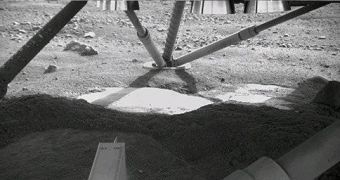On Saturday, NASA and University of Arizona mission controllers revealed an image taken with the camera on Phoenix's robotic arm showing a white patch of soil under the lander, which the team members believe to be water ice. The patch is about one meter in diameter, seems to be bright white and is surrounded by the three legs of the lander.
Previously, the team members had stated that they were hopping to find such a feature under the spacecraft, since the thruster engines should have blown enough material during landing to expose the ice sitting right bellow. "We were worried that it may be 30-, 40-, 50-centimeters deep, which would be a lot of work. Now we are fairly certain that we can easily get down to the ice table", said the chief project investigator of the mission Peter Smith from the University of Arizona.
Phoenix carries a robotic arm which it will use in its three month mission to dig and return samples to the spacecraft's instruments for a more detailed analysis. The main mission is to study the landing region, located in the northern polar regions of the planet, in order to determine whether or not water ice is present there and to establish if the planet was ever habitable for live. The spacecraft is still going through preparations at this moment, but should start digging in the Martian soil sometime this week.
Horst Uwe Keller, part of the team in charge of the camera on the robotic arm of the lander, says that within a couple of weeks the team will be able to determine if the white patch under Phoenix is water ice. However, new color images taken on Saturday should at least boost the confidence of the investigation team. As you can see, this particular image is in black and white.
After scooping samples of material from the ground, the robotic arm will deliver them to the analyzers who, in turn, will heat them up and study the gases resulted during the process. NASA reports that while taking pictures under the lander last week, one of the heating elements of the gas analyzer suffered a short circuit, but the second heating element will take its place.
Meanwhile, a hacker attack directed at the mission website forced the team from the University of Arizona to shut it down for a couple of hours for backup, maintenance and to repair the damage caused by the attacker. The security breach allegedly took place on Friday, when the hacker redirected the link of the University's site to his own.

 14 DAY TRIAL //
14 DAY TRIAL //